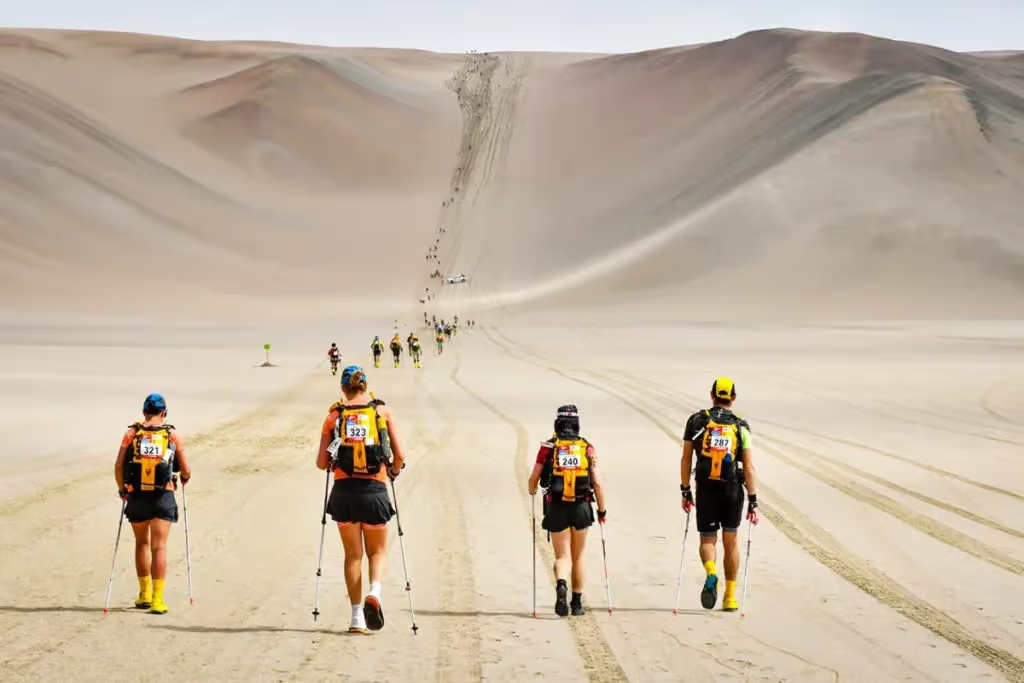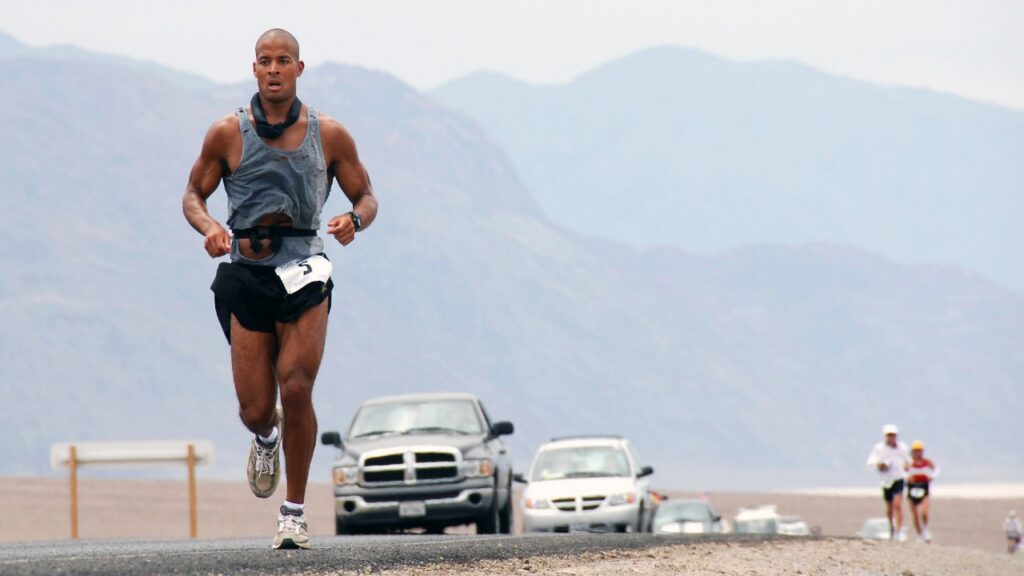Regular marathons test human endurance limits, but the world’s toughest marathon takes this challenge to the extreme. Standard marathons push runners through 26.2 miles under controlled conditions. The Antarctic Ice Marathon forces runners to battle temperatures dropping to -20°F (-29°C) while facing wind gusts up to 300 kilometers per hour. The Tenzing Hillary Everest Marathon starts at a staggering 17,598 feet above sea level, making it the highest marathon globally.
These extraordinary races stand apart from regular marathons because of their harsh environments and physical demands. The Great Wall Marathon challenges runners to climb 5,164 steps on slippery rocks and towers. This transforms the race into both a vertical challenge and an endurance test. The Inca Trail Marathon features an elevation gain of over 11,000 feet. Runners start at 8,650 feet and climb to almost 14,000 feet at the highest points. The Pikes Peak Marathon requires runners to climb nearly 8,000 feet. Average finish times reach 7:26:45—almost three hours slower than typical marathon times.
These extreme races represent the ultimate test of human capability and mental strength, from Antarctica’s freezing temperatures to Nepal’s thin air at high altitudes. This piece will explore what makes these courses so challenging, why elite runners approach them cautiously, and what specific obstacles each notorious route presents to brave athletes who dare to attempt them.

Table of Contents
- 1 What Makes a Marathon the Hardest?
- 2 The Inca Trail Marathon, Peru
- 3 The Everest Marathon, Nepal
- 4 The Pikes Peak Marathon, USA
- 5 The Antarctic Ice Marathon, Antarctica
- 6 Here are some FAQs about the hardest marathon in the world:
- 6.1 Which world major marathon is hardest?
- 6.2 What is the most extreme marathon in the world?
- 6.3 What are the 7 major marathons?
- 6.4 What is the hardest race in the world?
- 6.5 Which is the toughest marathon?
- 6.6 What is the coolest marathon on earth?
- 6.7 What are the 5 biggest marathons?
- 6.8 What is the most beautiful marathon to run?
- 6.9 How hard is the flying pig?
What Makes a Marathon the Hardest?
The world’s hardest marathon isn’t just about running 26.2 miles. Several key factors test human endurance beyond normal limits. Standard road marathons pale in comparison to these challenging races that turn into brutal survival tests.
1. Altitude and oxygen levels
Marathon performance changes drastically at high altitudes because runners get less oxygen. Runners experience lower endurance and slower times when they run above 5,000 feet. Their bodies struggle to give muscles enough oxygen. Studies show that running at altitude leads to lower maximal oxygen uptake (VO2max). Times become about 35% slower compared to sea level.
The effects on the body are huge. A 10 μg/m³ rise in particulate matter reduces performance by 1.4%. The best altitude training happens between 6,000-8,000 feet. At these heights, the body creates extra capillaries and blood vessels to make up for less oxygen.
2. Terrain and elevation gain
The toughest marathons feature brutal terrain changes. Hardrock includes a mind-boggling 30,000 feet of climbing and descent over 100.5 miles. Alaska’s Mount Marathon packs more than 3,000 feet of elevation into just 3.5 miles. It’s more like climbing a cliff than running.
These terrains change everything about how you run. Ancient cobblestone paths, uneven surfaces, and hidden trails don’t just slow you down – they make injuries more likely. The world’s hardest marathons mix technical terrain with steep climbs and unstable footing that test runners’ strength and balance constantly.
3. Weather extremes
Weather can turn a tough course into something impossible. The Antarctic Ice Marathon throws sub-zero temperatures and fierce winds at runners, making survival the real challenge. Badwater sits at the other end – runners face temperatures above 50°C (122°F).
Heat really changes how you run. Your heart rate goes up 2-4 beats per minute in 60-75°F weather. In 75-90°F conditions, it jumps up to 10 beats more per minute. High humidity makes things worse by trapping sweat, which can lead to heat exhaustion or heat stroke. Even small temperature increases matter – a 10-degree rise in “feels like” temperature means adding 10-20 seconds to each mile.
4. Self-sufficiency and logistics
The toughest marathons need runners to take care of themselves. The Marathon des Sables shows this perfectly – runners carry their food, water, and gear through the Sahara Desert. Carrying 5-6 liters of water plus supplies adds a huge physical challenge beyond just running.
Logistics create even more challenges. The Everest Marathon needs a two-week trek just to start. Some races have strict time limits that add pressure, while others offer minimal support, leaving runners on their own if problems come up.
5. Psychological and physical endurance
The mental game in extreme marathons is just as tough as the physical one. Elite runners use “association” to control their pace by listening to their body’s signals. Regular runners often use “dissociation” to distract themselves from pain.
Studies show runners who distract themselves during races hit the wall more often and run below their potential. The body runs out of carbohydrates after about two hours of running (around mile 20 for fast runners). It switches to burning fat, which leads to “bonking” or “hitting the wall”.
These five elements together make the world’s hardest marathon. The toughest races challenge human endurance by combining extreme altitude, brutal terrain, harsh weather, self-sufficiency, and mental challenges.
The Inca Trail Marathon, Peru
The Inca Trail Marathon stands alone as the world’s most grueling race. This Peruvian beast throws challenges at runners that other marathons wouldn’t dare include. Most hikers take 4-5 days to complete these ancient pathways, yet marathon participants must do it in one go [24, 30].
1. Over 11,000 feet of elevation gain
The race’s vertical challenge will take your breath away. Runners must climb about 10,400 feet and descend 11,000 feet throughout the course. These numbers dwarf what you’d see in standard marathons. The course leads athletes through four peaks – two mountain passes reaching 13,000 and 13,800 feet, plus two more peaks at 11,950 and 12,000 feet.
2. Starts at 8,650 feet and peaks near 14,000
The race begins at a lung-burning 8,650 feet above sea level. Runners must then climb to Dead Woman’s Pass at 4,215 meters (13,828 feet). The thin air at these heights makes breathing tough, and many athletes struggle with altitude sickness.
3. Ancient cobblestone paths and narrow trails
A 500-year-old cobblestone path, just 4-6 feet wide, serves as the race course. These historic trails were part of a massive network spanning 23,000 kilometers across the Inca Empire. Built for religious ceremonies rather than racing, these narrow paths are uneven and slippery. Runners must watch every step and maintain perfect balance.
4. Limited to 50 runners per year
The Peruvian government strictly protects this UNESCO World Heritage site. Only 40-50 lucky runners can participate each year. Spots sell out quickly due to the race’s legendary status. Athletes must reach the park entrance by 3:30 p.m. on race day, adding time pressure to their grueling experience.
5. Ends at Machu Picchu
The race ends at what might be marathon running’s most spectacular finish line – the legendary “Lost City of the Incas”. After conquering what many call Earth’s toughest marathon course, runners get rewarded with stunning views of this ancient wonder. Great Britain’s Mick Clifford holds the course record at 6:33:05, set in 2015. While this time might seem slow for regular marathons, it’s an extraordinary achievement on this brutal course.
This Andean route combines extreme physical challenges with incredible historical significance and natural beauty. It truly deserves its title as the world’s hardest marathon.

The Everest Marathon, Nepal
The Tenzing-Hillary Everest Marathon ranks among the world’s most challenging endurance events that pushes runners beyond their limits. Race organizers hold this event on May 29th to celebrate Tenzing Norgay and Sir Edmund Hillary’s first successful Everest summit in 1953. Athletes need extraordinary preparation that goes far beyond typical marathon training.
1. Starts at 17,598 feet at Everest Base Camp
The legendary Everest Base Camp (EBC) marks the marathon’s starting point at a staggering 5,364 meters (17,598 feet) above sea level. This elevation makes it the world’s highest marathon, where oxygen levels drop to about 50% of sea level amounts. The course runs downhill to Namche Bazaar (3,440m), yet the extreme altitude creates intense physical challenges. Runners must direct themselves through the first section beneath the iconic Khumbu Icefall, where climbers begin their path to Everest’s peak.
2. Requires a 2-week trek to the start line
This marathon stands unique as runners must complete a grueling multi-day trek to reach the starting line. The experience typically takes 10-14 days from Lukla, the closest airport. This time allows vital altitude adjustment. Athletes trek roughly 40 miles (65km) on narrow mountain trails they share with hikers, yaks, and local porters. The approach period has 5 strategic rest and adjustment days at specific locations including Lukla, Namche Bazaar, Dingboche, and Gorak Shep. No other marathon requires weeks of preparation just to reach its start.
3. Harsh terrain and thin air
The course runs mostly downhill but presents brutal challenges on rough, technical trails. Athletes face natural stone paths and high suspension bridges. The route has forest sections and steep climbs that seem impossible in thin air. Runners traverse through Sagarmatha National Park with dramatic elevation changes from 5,364m at the start to 3,440m at the finish—a total drop of about 1,924 meters (6,312 feet). The combination of rocky, uneven terrain and oxygen deprivation challenges even seasoned mountain runners.
4. Weather can change rapidly
The weather adds more uncertainty to this daunting challenge. Race organizers choose May for its stable conditions, yet temperatures vary drastically—from daytime highs of 10-20°C to nighttime lows of -5 to -10°C at higher altitudes. Unexpected snowstorms can dump 1-2 feet of snow and turn technical trails into dangerous paths. Mountain weather changes fast, so runners must prepare for clear skies, sunshine, sudden fog, rain, or snow during race day.
Therefore, this remarkable race draws only the most committed endurance athletes. It combines a marathon’s distance challenge with the mountaineering difficulties usually found in Himalayan expeditions.
The Pikes Peak Marathon, USA
The Pikes Peak Marathon started in 1956 as an unusual contest between smokers and non-smokers. Today it ranks among America’s most respected endurance events. Many experts call it the hardest marathon in the United States – a Colorado beast that puts standard marathons to shame.
1. 8,000 feet of vertical gain
The course punishes runners with about 7,815 feet (2,382m) of vertical climb from start to summit. This relentless uphill grind takes its toll on even the most experienced mountain runners. Runners begin in Manitou Springs and face an average grade of 11% with barely any flat sections during the climb. The extreme height gain means runners take longer to reach the top than they’d need for a regular flatland marathon. The journey starts with 1.5 miles of road before connecting to the historic Barr Trail for the rest of this brutal climb.
2. Peak altitude of 14,115 feet
Pikes Peak reaches an incredible 14,115 feet (4,302m) above sea level, which makes breathing extremely difficult. The body struggles more as runners climb higher. At the summit, air pressure drops to about 430 mm Hg – that’s 43% less oxygen than at sea level. This dramatic drop in oxygen creates a chain of physical stress. The body works harder but gets nowhere near enough fuel. Put simply, runners have about half the oxygen at the peak compared to sea-level spots.
3. Rugged, narrow trails
The tough terrain adds another challenge beyond the elevation. Barr Trail weaves through pine and aspen forests before it climbs above treeline into alpine territory. Trail surfaces change dramatically. Forest sections mix decomposed rock with dirt and loose gravel, while roots and rocks stick out unexpectedly. Above treeline, runners tackle mostly loose gravel and broken rock until they meet the infamous “16 Golden Stairs” – 32 switchbacks with 10-15 inch step-ups each. The narrow, winding path leaves little space to pass others and demands complete focus to stay upright.
4. Qualifying race required
The race’s extreme nature means runners must qualify through previous races. Officials use verified results that meet specific standards to calculate an “Estimated Ascent Time” for wave placement. A wave start system helps reduce crowding on the narrow trails. Runners can qualify through previous Pikes Peak events, trail races over 10 miles, any event beyond 26.2 miles, or races with at least 4,000 feet of elevation change. These tough requirements ensure runners are ready for what many call “America’s Ultimate Challenge”.
The Antarctic Ice Marathon, Antarctica
The Antarctic wilderness hosts what many think over to be Earth’s most brutal marathon, located just 600 miles from the South Pole. This race pushes human endurance to its absolute limits, and survival becomes a victory in itself.
1. Sub-zero temperatures and wind chills
Runners at the Antarctic Ice Marathon battle average windchill temperatures of -20°C (-4°F). Steady katabatic winds blow from the Pole at 10-25 knots, making exposed skin vulnerable to frostbite within minutes. The race just needs participants to wear complete polar gear: balaclavas, goggles, heavy gloves, and multiple thermal layers. Many runners still face breathing difficulties from the intense cold.
2. Remote location and high cost
This extraordinary race demands a steadfast dedication – physically and financially. A $22,500 registration fee covers your round-trip flights from Punta Arenas, Chile, to Union Glacier camp deep in Antarctica. Runners land on a blue-ice runway and find themselves completely isolated, with minimal evacuation options.
3. Snow and ice terrain
The snow-packed surface makes each step challenging. Running on snow and ice drains energy and creates unique physical demands that force athletes to fine-tune their expectations. The uneven, shifting terrain requires constant focus and adaptation, unlike typical road marathons.
4. Limited support and isolation
Runners face deep solitude in this hushed, unconquerable landscape. The route has no cheering crowds—you won’t find penguins this far south. Each competitor must be self-reliant in an environment where they must collect human waste and where medical emergencies could become catastrophic.
Marathon running tests human endurance to its limits, but the races covered in this piece go beyond normal challenges. These remarkable events stand out from regular marathons in several key ways. The brutal environment combined with physical demands makes them unique. Runners in the Antarctic Ice Marathon face temperatures dropping to -20°F. The Everest Marathon begins at a staggering 17,598 feet where oxygen levels are just half of what’s available at sea level.
The terrain itself poses a huge challenge. The Inca Trail Marathon’s ancient cobblestone paths are barely 4-6 feet wide with over 11,000 feet of climbing. The Pikes Peak Marathon’s rugged, narrow trails force runners to climb almost 8,000 feet straight up, with steep 11% grades throughout the course.
These aren’t your typical races – they just need extraordinary preparation. Athletes must spend two weeks trekking just to reach the Everest Marathon’s starting line. The Antarctic Ice Marathon’s remote location and specialized polar gear requirements explain its hefty $22,500 entry fee.
Even elite runners approach these races with caution because the risks are real. High-altitude weather changes faster than expected. Many trails run along steep drops, and medical help is often far away. There’s another reason these races take two or three times longer than standard marathons.
Without doubt, these extreme races are the ultimate marathon challenge. They draw a unique type of athlete who wants to find their absolute human limits rather than just test their speed. Regular marathons might track minutes and seconds, but these extraordinary challenges measure success by survival and completion. While few will ever run these brutal courses, they show how far humans will go to challenge what they think is possible.
Here are some FAQs about the hardest marathon in the world:
Which world major marathon is hardest?
Many runners consider the Boston Marathon to be the hardest of the World Marathon Majors due to its challenging Newton Hills, particularly the infamous Heartbreak Hill. The course’s elevation changes and qualifying standards make it a tough challenge even for experienced marathoners.
What is the most extreme marathon in the world?
The most extreme marathon in the world is arguably the Barkley Marathons in Tennessee, which has a near-impossible completion rate. This race goes far beyond a standard marathon with its 100+ mile distance, brutal terrain, and sleep deprivation requirements, making it what is the hardest marathon in the world for many ultrarunners.
What are the 7 major marathons?
The seven major marathons include the six World Marathon Majors – Tokyo, Boston, London, Berlin, Chicago, and New York City – plus the World Athletics Championships Marathon. These events represent the pinnacle of distance running and include some of the hardest marathon in the world courses like Boston.
What is the hardest race in the world?
The hardest race in the world is widely considered to be the Barkley Marathons, which has seen only a handful of finishers since its inception. This ultramarathon’s combination of distance, navigation challenges, and extreme elevation gain solidifies its reputation as what’s the hardest marathon in the world category.
Which is the toughest marathon?
The toughest standard marathon distance race is often considered to be the Inca Trail Marathon in Peru, which reaches altitudes over 13,800 feet. This high-altitude course with ancient stone steps presents challenges that make it the hardest marathon in the world for many participants.
What is the coolest marathon on earth?
The Antarctica Marathon is often called the coolest marathon on earth both literally and figuratively, with runners braving sub-zero temperatures on the frozen continent. While extremely challenging due to weather conditions, it’s different from discussions about the hardest half marathon in the world which focus more on course difficulty than environment.
What are the 5 biggest marathons?
The five biggest marathons by participation are typically Tokyo, Boston, London, Berlin, and Chicago, which along with New York City form the World Marathon Majors. Among these, Boston is often considered what is the hardest marathon in the world of the major races due to its qualifying standards and course profile.
What is the most beautiful marathon to run?
The Big Sur International Marathon in California is frequently called the most beautiful marathon with its stunning coastal views along Highway 1. While scenic, its rolling hills also present a substantial challenge, though not typically ranking as the hardest half marathon in the world in terms of pure difficulty.
How hard is the flying pig?
The Flying Pig Marathon in Cincinnati is considered moderately challenging with significant hills throughout the first half of the course. While demanding, it doesn’t compare to what’s the hardest marathon in the world like the Barkley Marathons or high-altitude races.


